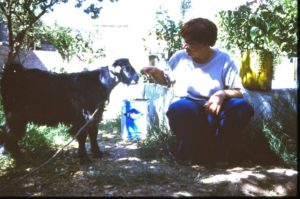Originally published in the newsletter of the GUPPIES chapter of Sisters in Crime, September 2017, as “Me? I Couldn’t Kill an Ant!”
Once, when I was a young child, I squished an ant. I believe I intended to kill it, but my finger managed only to get the back end. I watched, fascinated, as the head and a few legs and tentacles struggled to move the squashed end across the counter of my doctor’s office.
“We are a place of healing. We don’t cause suffering here!” I will never forget the tone the receptionist. Never since have I been able to kill an ant, or any other creatures, without being deeply affected by even the remotest possibility that I might cause suffering.
 This is why, for example, I sat all day with a goat destined for slaughter; it bleated so sadly, separated from its family, awaiting its fate. It is also perhaps why, despite mystery being my favorite genre to read, I sometimes have to take a break after particularly violent reads. It has certainly impacted my ability to write a murder. At least until very recently.
This is why, for example, I sat all day with a goat destined for slaughter; it bleated so sadly, separated from its family, awaiting its fate. It is also perhaps why, despite mystery being my favorite genre to read, I sometimes have to take a break after particularly violent reads. It has certainly impacted my ability to write a murder. At least until very recently.
I may prefer a gentle cozy. Still, I have not shied away from reading psychological thrillers, serial killers who torture their victims (true and fictional), or other sub-genres with plenty of emotional and physical suffering.
But I have wondered: How does Stephen King come up with, let alone sit and write his torture scenes? How does Louise Penny continually confront her characters with trauma after trauma? How did Elizabeth Peters put her protagonists through such cruel torment, book after book? How does Jane Haddam create a Gregor Demarkian so haunted by cruelty in the world and still able to love?
Of course, everyone knows that writers must push their protagonists to their limits — for the sake of the story. Perhaps my writing wasn’t yet good because I struggled with this writing rule.
But something shifted a few years ago, when I was mad at my boss. On a walk in the woods, I thought of the perfect scenario — where to dump a body (my boss came to mind), how to have it discovered (for a proper burial) but the murderer’s tracks covered. I went home and drafted a story (unpublished), including motive and method for murder. Writing the fictional murder of a character with some of the traits of my boss — especially what had made me so mad — was cathartic!
And suddenly I understood. Writing a murder isn’t committing a murder. Pushing a character to the emotional breaking point isn’t causing real suffering. Reading has helped me navigate the world, and writing has been my outlet. I cannot abide real suffering — there is far too much of it in our world. But writing suffering into my characters can save my sanity, and even help others navigate their feelings.
I’ve now “killed” enough in words to have several mysteries in written or conceived phase — onward to querying! My former boss is, to my knowledge, alive and well. The character no longer resembles her at all. The ant is long dead, and I reconcile killing the moths that are eating my clothes fairly well. And that goat? It tasted wonderful, cooked fresh the day of slaughter. I only hope I made its last day a bit more pleasant, just as I hope that I offer readers a chance to navigate their emotions through my writing.
